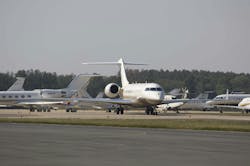Safeguarding the Future of General Aviation

Last May, President Biden signed into law the FAA Reauthorization Act of 2024 (ACT). This long-awaited and comprehensive legislation reauthorizes the Federal Aviation Administration (FAA), and the aviation infrastructure and safety programs it administers, through 2028.
Importantly, the ACT includes significant measures to protect and promote general aviation in the U.S. The law recognizes general aviation’s significance in the national airspace system and includes the first-ever general aviation title dedicated to securing the industry’s long-term success.
The ACT includes provisions to protect and expand pilot privileges, make robust investments in general aviation airports and build pathways for young people to pursue aviation careers. It also addresses the need for safe and smart transition to an unleaded fleetwide fuel by 2030, funding for small airports and preventing the permanent closure of federally-funded airports.
For example, here are summaries of a few key general aviation related provisions contained in the ACT:
· Authorizes $4 billion a year for the FAA’s airport projects program, an expansion from the current $3.35 billion annual spending level, with most of this increase allocated to funding for general aviation airports.
· Provides $34 million per year in the small airport fund for construction of itinerant and transient general aviation parking.
· Protects U.S. civil aviation interests by rejecting the permanent closure of any grant-obligated airport unless the closure will not significantly impair the aeronautical purpose of an airport.
· Requires airports that offered 100LL aviation gasoline for sale in 2022 to continue offering the sale of 100LL until 2030 or the date on which the FAA certifies an unleaded aviation gasoline alternative is available for purchase or use, with some exceptions.
· Authorizes $20 million for aircraft pilot, aviation maintenance and aviation manufacturing workforce development programs.
Clearly, the ACT recognizes that our aviation system needs a healthy general aviation sector. But, can it protect airports from operational, access and land use restrictions being proposed by a growing number of legislators and noise activists at the local level?
The unfortunate answer is no. Even with the ACT in place, communities across the U.S. are placing increased pressure on legislators to respond to what they perceive as a growing airport noise and emissions problem. These measures threaten to damage the national airspace system, weaken the economic base of communities and undermine the Aircraft Noise and Capacity Act (ANCA) of 1990.
It is important to consider that ANCA was intended to shift responsibility for noise abatement away from local governments and airport sponsors, and to grant the FAA preemptive authority over the setting of noise levels and imposition of noise and capacity restrictions at airports. It was also believed that shifting toward a national solution would result in less litigation and more cooperation among airport stakeholders in regard to airport noise issues.
In simple terms, ANCA both required the phase-out of Stage 2 aircraft weighing more than 75,000 pounds and regulated an airport’s ability to operationally restrict Stage 2 and Stage 3 aircraft.
It also made airports seeking to limit or restrict the operation of Stage 2 or Stage 3 aircraft for noise mitigation purposes subject to FAR Part 161 regulations, which provide a study methodology for airports to prove to the FAA that an exception to ANCA is warranted.
The consequences for airports that fail to comply with ANCA are severe. If an airport adopts a noise or access restriction without following regulation, it may lose eligibility for Airport Improvement Program grants and access to Passenger Facility Charges. To date, no airports have successfully received approval from the FAA to impose noise restrictions, such as a mandatory curfew, through the FAR Part 161 process.
The options available to address noise concerns associated with airports and aircraft operations remain limited, and finding a balanced solution is a daunting task. This is especially the case when dealing with city planning policies that have allowed homes to be constructed next to airports in the first place, as well as residents who moved into these neighborhoods post-ANCA.
According to research published by the Congressional Research Service in 2021, multiple factors have contributed to increased concerns about aircraft noise which could continue to influence national and local policy. These include:
· Population growth and pressure for housing construction around major airports, especially in metropolitan areas;
· Increases in air traffic and changes in flight operations that intensify existing noise exposure or raise noise levels in areas that may not have experienced annoyance from aircraft noise previously;
· Elevated public awareness of the adverse effects of aircraft noise on individuals and communities, leading to greater community engagement with noise issues; and
· Continuing debate over whether there should be an alternative noise metric other than the current DNL and whether or not the DNL 65 dB threshold should be lowered to reflect increased community sensitivity to aircraft noise.
Ultimately, the FAA is responsible for the safe and efficient use of the national airspace system. Community recommendations regarding changes to air traffic rules, the use of airspace or the control of air traffic must be addressed at the federal level. Airport sponsors must work in collaboration with aviation trade associations and industry partners to educate stakeholders of this reality.
It is time for the FAA to take a firm stand on enforcing all provisions of ANCA. This means any efforts by local governments to prevent aeronautical development, change key land use designations to non-aeronautical, limit aircraft operations and impose new noise restrictions will be deemed discriminatory and in violation of the airport’s federal grant assurances.
The economic health of communities, protection of general aviation airports and preservation of our national airspace system depend on it.
About the Author

Curt Castagna
President and CEO
Curt Castagna, President/CEO of Ascension Group Partners, serves as president and CEO of the National Air Transportation Association, member and past chair of the Los Angeles County Airport Commission, and president of the Van Nuys and Long Beach airport associations. A certified private, seaplane and instrument-rated pilot, he continues to instruct courses in aviation administration at Cypress Community College and Cal State Los Angeles.